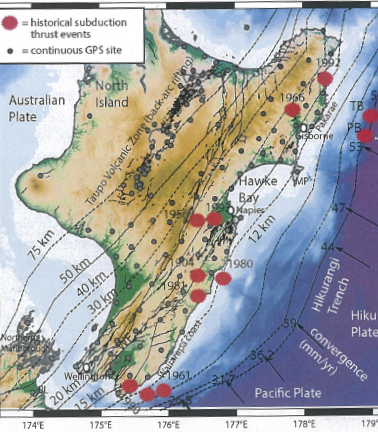Introduction
A joint venture
In 2016, scholars from the Joint Centre for Disaster Research (JCDR) and Geological and Nuclear Sciences (GNS) identified that the public do not sufficiently understand tsunami risk. In particular, there is little awareness regarding the three different types of tsunami; local, regional and distant and that each type requires a differing response and warning communication method. For example the shake is the warning for a local tsunami and immediate action should be taken to get to higher ground.
In response to these findings, JCDR and GNS set up a research project where a Master of Design student and a Master of Communication student could both explore new communications of tsunami risk and warning systems for Aotearoa. This is the Masters of Design response to that project.
I was drawn to this research because of my own experiences with tsunami warnings. Over the years Turanganui-a-Kiwa has experienced multiple tsunami warnings that have been triggered by local and distant earthquakes. An example of this was the Kaikoura 2016 earthquake that triggered a tsunami warning for the East Cape. While the community of Tūranga live with the awareness of our vulnerability to tsunami, often we expect the warnings sent by Civil Defence and the media will provide us with enough information and notice to protect our whanau, hapū and iwi. Therefore I have a huge appreciation for systems that communicate warnings across Aotearoa. I was selected as the Master of Design candidate to carry out this research and embraced the opportunity to focus on my own community, Tūranga, which is a part of the wider region Tūranganui-a-Kiwa, a place I consider my tūrangawaewae.
Cultural context
Tūranganui-a-Kiwa is the original place name for the Gisborne area, otherwise known as Poverty Bay. There are different explanations of how Tūranganui-a-Kiwa derived its name, but according to Tūpara (2005) one account refers to Kiwa, an ancestor from the Tākitimu waka, who waited for the arrival of the Horouta. The arrival took so long that Kiwa named the final landing place the “long waiting place of Kiwa” or “the standing place of Kiwa”. The four main iwi that occupy this area are Te Aitanga-a-Māhaki, Rongowhakaata, Ngai Tāmanuhiri and my own iwi Te Aitanga-a-Hauiti. It is important to understand the specificness of this whenua because the tangata whenua who live here hold various bodies of knowledge that could inform a risk management strategy and design response pertinent to the local context, thereby contributing to our society a solution more likely to resonate with the community. The method of acknowledging the contextual location of Tūranga is crucial in understanding the community’s needs to raise tsunami awareness for their own iwi, hapū and whanau. Research into the nature of our whenua, particularly the Hikurangi Subduction Zone, strongly indicates the severity in which a tsunami may affect Tūranga, and the importance of understanding and preparing for this potential event.
Research aims
King, Goff & Skipper (2007) suggest that by allowing the community to share responsibility for their response to an unfolding crisis, it opens up new opportunities to raise awareness. I see huge potential to bring together government entities, JCDR and GNS with the community of Tūranga into a meaningful and collectively-oriented project. My research aims to uncover this potential, and perhaps also offer approaches and working methods for other researchers in the future. I am interested in exploring traditional Mātauranga Māori and Māori values to improve natural hazard communications for Tūranga. This project aims to respond to the research question:
How can Mātauranga Māori produce a meaningful and relevant narrative to enhance community conversations that raise awareness of tsunami risk and inform new tsunami communications for Tūranganui-a-Kiwa?
In order to unpack this question, this thesis has been broken down into four key components that informed the project's scope, methods and context. The design-led research will explore:
Section 1.0
Risk communications in Aotearoa to develop an understanding of current communication methods.
Section 2.0
Human-Centred Design methodology and the process of co-design that was used to build empathy with my community and reveal the underlying problems affecting tsunami awareness and preparedness in Tūranga.
Section 4.0
The design process and the final design outcome.
